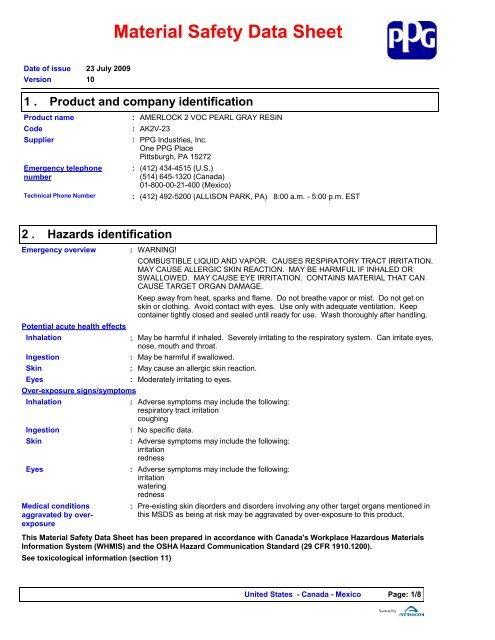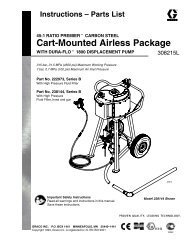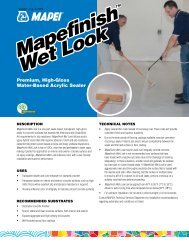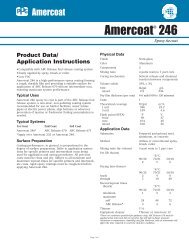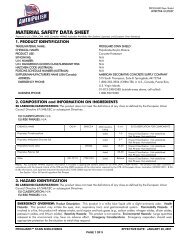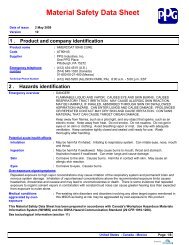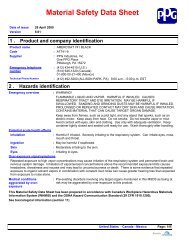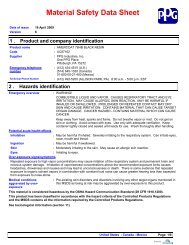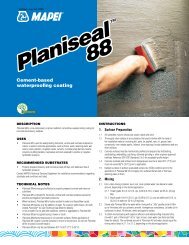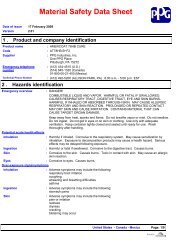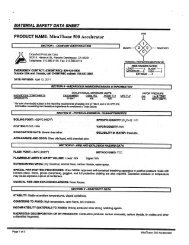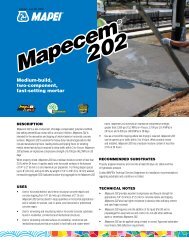Amercoat 2 VOC - Pearl Gray MSDS - AltaPaints and Coatings
Amercoat 2 VOC - Pearl Gray MSDS - AltaPaints and Coatings
Amercoat 2 VOC - Pearl Gray MSDS - AltaPaints and Coatings
You also want an ePaper? Increase the reach of your titles
YUMPU automatically turns print PDFs into web optimized ePapers that Google loves.
Material Safety Data SheetDate of issue 23 July 2009Version 101 .Product <strong>and</strong> company identificationProduct nameCodeSupplierEmergency telephonenumberTechnical Phone Number: AMERLOCK 2 <strong>VOC</strong> PEARL GRAY RESIN:::AK2V-23PPG Industries, Inc.One PPG PlacePittsburgh, PA 15272(412) 434-4515 (U.S.)(514) 645-1320 (Canada)01-800-00-21-400 (Mexico): (412) 492-5200 (ALLISON PARK, PA) 8:00 a.m. - 5:00 p.m. EST2 .Hazards identificationEmergency overviewPotential acute health effectsInhalationIngestionSkinEyesOver-exposure signs/symptomsInhalationIngestionSkinEyesMedical conditionsaggravated by overexposureWARNING!See toxicological information (section 11)::::::COMBUSTIBLE LIQUID AND VAPOR. CAUSES RESPIRATORY TRACT IRRITATION.MAY CAUSE ALLERGIC SKIN REACTION. MAY BE HARMFUL IF INHALED ORSWALLOWED. MAY CAUSE EYE IRRITATION. CONTAINS MATERIAL THAT CANCAUSE TARGET ORGAN DAMAGE.Keep away from heat, sparks <strong>and</strong> flame. Do not breathe vapor or mist. Do not get onskin or clothing. Avoid contact with eyes. Use only with adequate ventilation. Keepcontainer tightly closed <strong>and</strong> sealed until ready for use. Wash thoroughly after h<strong>and</strong>ling.May be harmful if inhaled. Severely irritating to the respiratory system. Can irritate eyes,nose, mouth <strong>and</strong> throat.May be harmful if swallowed.May cause an allergic skin reaction.Moderately irritating to eyes.: Adverse symptoms may include the following:respiratory tract irritationcoughing: No specific data.: Adverse symptoms may include the following:irritationredness: Adverse symptoms may include the following:irritationwateringrednessPre-existing skin disorders <strong>and</strong> disorders involving any other target organs mentioned inthis <strong>MSDS</strong> as being at risk may be aggravated by over-exposure to this product.This Material Safety Data Sheet has been prepared in accordance with Canada's Workplace Hazardous MaterialsInformation System (WHMIS) <strong>and</strong> the OSHA Hazard Communication St<strong>and</strong>ard (29 CFR 1910.1200).United States - Canada - MexicoPage: 1/8
Product code AK2V-23 Date of issue 23 July 2009 VersionProduct name AMERLOCK 2 <strong>VOC</strong> PEARL GRAY RESIN103 .Composition/information on ingredientsName CAS number %reaction product: bisphenol-A-(epichlorhydrin) <strong>and</strong> epoxy resin (number average 25068-38-6 30 - 60molecular weight
Product code AK2V-23 Date of issue 23 July 2009 VersionProduct name AMERLOCK 2 <strong>VOC</strong> PEARL GRAY RESIN106 .Accidental release measuresPersonal precautions :Environmental precautionsLarge spill :Small spill :7 .H<strong>and</strong>lingH<strong>and</strong>ling <strong>and</strong> storage:No action shall be taken involving any personal risk or without suitable training.Evacuate surrounding areas. Keep unnecessary <strong>and</strong> unprotected personnel fromentering. Do not touch or walk through spilled material. Shut off all ignition sources. Noflares, smoking or flames in hazard area. Avoid breathing vapor or mist. Provideadequate ventilation. Wear appropriate respirator when ventilation is inadequate. Puton appropriate personal protective equipment (see section 8).: Avoid dispersal of spilled material <strong>and</strong> runoff <strong>and</strong> contact with soil, waterways, drains <strong>and</strong>sewers. Inform the relevant authorities if the product has caused environmental pollution(sewers, waterways, soil or air).Stop leak if without risk. Move containers from spill area. Approach release fromupwind. Use spark-proof tools <strong>and</strong> explosion-proof equipment. Prevent entry intosewers, water courses, basements or confined areas. Wash spillages into an effluenttreatment plant or proceed as follows. Contain <strong>and</strong> collect spillage with non-combustible,absorbent material e.g. s<strong>and</strong>, earth, vermiculite or diatomaceous earth <strong>and</strong> place incontainer for disposal according to local regulations (see section 13). Dispose of via alicensed waste disposal contractor. Contaminated absorbent material may pose thesame hazard as the spilled product. Note: see section 1 for emergency contactinformation <strong>and</strong> section 13 for waste disposal.Stop leak if without risk. Move containers from spill area. Use spark-proof tools <strong>and</strong>explosion-proof equipment. Dilute with water <strong>and</strong> mop up if water-soluble or absorb withan inert dry material <strong>and</strong> place in an appropriate waste disposal container. Dispose ofvia a licensed waste disposal contractor.Put on appropriate personal protective equipment (see section 8). Eating, drinking <strong>and</strong>smoking should be prohibited in areas where this material is h<strong>and</strong>led, stored <strong>and</strong>processed. Persons with a history of skin sensitization problems should not be employedin any process in which this product is used. Do not breathe vapor or mist. Do notswallow. Do not get in eyes or on skin or clothing. Use only with adequate ventilation.Wear appropriate respirator when ventilation is inadequate. Do not enter storage areas<strong>and</strong> confined spaces unless adequately ventilated. Keep in the original container or anapproved alternative made from a compatible material, kept tightly closed when not inuse. Store <strong>and</strong> use away from heat, sparks, open flame or any other ignition source.Use explosion-proof electrical (ventilating, lighting <strong>and</strong> material h<strong>and</strong>ling) equipment.Use non-sparking tools. Take precautionary measures against electrostatic discharges.Vapors are heavier than air <strong>and</strong> may spread along floors. To avoid fire or explosion,dissipate static electricity during transfer by grounding <strong>and</strong> bonding containers <strong>and</strong>equipment before transferring material. Empty containers retain product residue <strong>and</strong> canbe hazardous. Do not reuse container. If this material is part of a multiple componentsystem, read the Material Safety Data Sheet(s) for the other component or componentsbefore blending as the resulting mixture may have the hazards of all of its parts.Storage:Store in accordance with local regulations. Store in a segregated <strong>and</strong> approved area.Store in original container protected from direct sunlight in a dry, cool <strong>and</strong> well-ventilatedarea, away from incompatible materials (see section 10) <strong>and</strong> food <strong>and</strong> drink. Eliminateall ignition sources. Separate from oxidizing materials. Keep container tightly closed<strong>and</strong> sealed until ready for use. Containers that have been opened must be carefullyresealed <strong>and</strong> kept upright to prevent leakage. Do not store in unlabeled containers. Useappropriate containment to avoid environmental contamination. Do not store above thefollowing temperature: 120F / 49C.United States - Canada - MexicoPage: 3/8
Product code AK2V-23 Date of issue 23 July 2009 VersionProduct name AMERLOCK 2 <strong>VOC</strong> PEARL GRAY RESIN8 .Exposure controls/personal protection10Name Result ACGIH OSHA Ontario Mexico PPGTalc (Mg3H2(SiO3)4) TWA 2 mg/m³ R 20 mppcf Z 2 f/cc2 mg/m³ RTDSTEL Not 1 f/cc Z Notestablishedestablished____________________________Key to abbreviationsA = Acceptable Maximum PeakS = Potential skin absorptionACGIH = American Conference of Governmental Industrial Hygienists. SR = Respiratory sensitizationC = Ceiling LimitSS = Skin sensitizationF = FumeTD = Total dustIPEL = Internal Permissible Exposure LimitTLV = Threshold Limit ValueOSHA = Occupational Safety <strong>and</strong> Health Administration.TWA = Time Weighted AverageR = Respirable Z = OSHA 29CFR 1910.1200 Subpart Z - Toxic <strong>and</strong> HazardousSubstancesConsult local authorities for acceptable exposure limits.Recommended monitoringproceduresEngineering measuresHygiene measuresPersonal protectionEyesH<strong>and</strong>sGloves :RespiratorySkin: If this product contains ingredients with exposure limits, personal, workplace atmosphereor biological monitoring may be required to determine the effectiveness of the ventilationor other control measures <strong>and</strong>/or the necessity to use respiratory protective equipment.: Use only with adequate ventilation. Use process enclosures, local exhaust ventilation orother engineering controls to keep worker exposure to airborne contaminants below anyrecommended or statutory limits. The engineering controls also need to keep gas, vaporor dust concentrations below any lower explosive limits. Use explosion-proof ventilationequipment.: Wash h<strong>and</strong>s, forearms <strong>and</strong> face thoroughly after h<strong>and</strong>ling chemical products, beforeeating, smoking <strong>and</strong> using the lavatory <strong>and</strong> at the end of the working period. Appropriatetechniques should be used to remove potentially contaminated clothing. Washcontaminated clothing before reusing. Ensure that eyewash stations <strong>and</strong> safety showersare close to the workstation location.:::Safety glasses with side shields.: Chemical-resistant, impervious gloves complying with an approved st<strong>and</strong>ard should beworn at all times when h<strong>and</strong>ling chemical products if a risk assessment indicates this isnecessary.butyl rubber2 mg/m³ NotestablishedNotestablishedNotestablished___________ ___________ ___________ ___________ ___________ ___________tert-butyl acetate TWA 200 ppm 200 ppm 200 ppm 200 ppm NotestablishedSTEL Not NotNot 250 ppm Notestablished established establishedestablished____________________________ ___________ ___________ ___________ ___________ ___________ ___________titanium dioxide TWA 10 mg/m³ 15 mg/m³ TD 10 mg/m³ TD 10 mg/m³ (as NotTi)establishedSTEL Not NotNot 20 mg/m³ (as Notestablished established established Ti)established____________________________ ___________ ___________ ___________ ___________ ___________ ___________If workers are exposed to concentrations above the exposure limit, they must useappropriate, certified respirators. Use a properly fitted, air-purifying or air-fed respiratorcomplying with an approved st<strong>and</strong>ard if a risk assessment indicates this is necessary.Respirator selection must be based on known or anticipated exposure levels, thehazards of the product <strong>and</strong> the safe working limits of the selected respirator.Personal protective equipment for the body should be selected based on the task beingperformed <strong>and</strong> the risks involved <strong>and</strong> should be approved by a specialist before h<strong>and</strong>lingthis product.United States - Canada - MexicoPage: 4/8
Product code AK2V-23 Date of issue 23 July 2009 VersionProduct name AMERLOCK 2 <strong>VOC</strong> PEARL GRAY RESIN8 .Exposure controls/personal protectionEnvironmental exposurecontrols9 .Physical stateFlash point: Emissions from ventilation or work process equipment should be checked to ensure theycomply with the requirements of environmental protection legislation. In some cases,fume scrubbers, filters or engineering modifications to the process equipment will benecessary to reduce emissions to acceptable levels.Physical <strong>and</strong> chemical propertiesLiquid.Explosion limits : Lower: 1.2%ColorOdorpHBoiling/condensation pointMelting/freezing pointSpecific gravityVapor pressureVapor densityVolatilityOdor thresholdEvaporation rate:: Closed cup: 38.33°C (101°F):::::::::::Not available.Not available.Not available.>37.78°C (>100°F)Not available.1.42Density ( lbs / gal ) : 11.85Octanol/water partitioncoefficient% Solid. (w/w) : 93.720.15 kPa (1.1 mm Hg)Not available.10% (v/v), 6.28% (w/w)Not available.10 (butyl acetate = 1): Not available.1010 .StabilityStability <strong>and</strong> reactivityConditions to avoidMaterials to avoidHazardous decompositionproductsHazardous polymerization:::::Stable under recommended storage <strong>and</strong> h<strong>and</strong>ling conditions (see section 7).Avoid all possible sources of ignition (spark or flame). Do not pressurize, cut, weld,braze, solder, drill, grind or expose containers to heat or sources of ignition.Reactive or incompatible with the following materials:,acids,oxidizing materials,strongalkalisUnder normal conditions of storage <strong>and</strong> use, hazardous decomposition products shouldnot be produced.Under normal conditions of storage <strong>and</strong> use, hazardous polymerization will not occur.11 .Toxicological informationAcute toxicityProduct/ingredient name Result Species Dose Exposurereaction product: bisphenol-A-LD50 Oral Rat >2 g/kg -(epichlorhydrin) <strong>and</strong> epoxy resin (numberaverage molecular weight 2 g/kg -tert-butyl acetate LD50 Oral Rat 4100 mg/kg -LD50 Dermal Rabbit >2 g/kg -LC50 Inhalation Rat >2230 mg/m3 4 hourstitanium dioxide LD50 Oral Rat >10 g/kg -Conclusion/Summary: Not available.United States - Canada - MexicoPage: 5/8
Product code AK2V-23 Date of issue 23 July 2009 VersionProduct name AMERLOCK 2 <strong>VOC</strong> PEARL GRAY RESIN11 .Toxicological informationChronic toxicityConclusion/SummaryTarget organsCarcinogenicityConclusion/SummaryCarcinogenicityClassification: Not available.: Not available.Product/ingredient name ACGIH IARC EPA NIOSH NTP OSHATalc (Mg3H2(SiO3)4) A4 3 - - - -titanium dioxide A4 2B - - - -MutagenicityConclusion/SummaryMutagenicityTeratogenicityConclusion/SummaryTeratogenicityReproductive toxicityConclusion/SummaryDevelopmental effectsFertility effects12 .: Contains material which causes damage to the following organs: lungs, skin, centralnervous system (CNS).Contains material which may cause damage to the following organs: cardiovascularsystem, upper respiratory tract, eyes.: Contains material which may cause cancer, based on animal data. Risk of cancerdepends on duration <strong>and</strong> level of exposure.: Not available.: No known significant effects or critical hazards.: Not available.: No known significant effects or critical hazards.: Not available.Ecological informationEnvironmental effectsAquatic ecotoxicity: No known significant effects or critical hazards.: No known significant effects or critical hazards.: No known significant effects or critical hazards.Product/ingredientnameResultSpeciesExposuretert-butyl acetate Acute LC50 327000 to 362000 ug/L Fish - Fathead minnow - Pimephales 96 hoursFresh waterpromelas______________________ _________________________________ ________________________________ __________titanium dioxide Acute LC50 5.5 ppm Fresh water Daphnia - Water flea - Daphnia magna 48 hours_________________________________ ________________________________ __________Chronic NOEC 1 ppm Fresh water Daphnia - Water flea - Daphnia magna 48 hours______________________ _________________________________ ________________________________ __________13 .Disposal considerationsWaste disposal:The generation of waste should be avoided or minimized wherever possible. Emptycontainers or liners may retain some product residues. This material <strong>and</strong> its containermust be disposed of in a safe way. Dispose of surplus <strong>and</strong> non-recyclable products via alicensed waste disposal contractor. Disposal of this product, solutions <strong>and</strong> any byproductsshould at all times comply with the requirements of environmental protection<strong>and</strong> waste disposal legislation <strong>and</strong> any regional local authority requirements. Avoiddispersal of spilled material <strong>and</strong> runoff <strong>and</strong> contact with soil, waterways, drains <strong>and</strong>sewers.Disposal should be in accordance with applicable regional, national <strong>and</strong> local laws <strong>and</strong> regulations.Refer to Section 7: HANDLING AND STORAGE <strong>and</strong> Section 8: EXPOSURE CONTROLS/PERSONAL PROTECTIONfor additional h<strong>and</strong>ling information <strong>and</strong> protection of employees. Section 6. Accidental release measures10United States - Canada - MexicoPage: 6/8
Product code AK2V-23 Date of issue 23 July 2009 VersionProduct name AMERLOCK 2 <strong>VOC</strong> PEARL GRAY RESIN14 .Transport information10Regulation UN number Proper shipping name Classes PG*UN 1263 Paint 3 IIIIMDG 1263 Paint 3 III -DOTPG* : Packing groupReportable quantity RQ :15 .1263 Paint3Regulatory informationUnited States inventory (TSCA 8b) :Australia inventory (AICS)Canada inventory :China inventory (IECSC) :Europe inventory :Japan inventory (ENCS) :Korea inventory (KECI) :New Zeal<strong>and</strong> :Philippines inventory (PICCS) :United StatesU.S. Federal regulationsCERCLA: Hazardous substances.: tert-butyl acetate: 5000 lbs. (2270 kg);IIIAdditional information-RemarksUSA Only: Can be reclassifiedas Combustible Liquid. Non-Bulk highway shipments (Lessthan or Equal to 450Liters) canbe shipped as non-regulated.TSCA 12(b) one-time export: No products were found.SARA 302/304/311/312 extremely hazardous substances: No products were found.SARA 302/304 emergency planning <strong>and</strong> notification: No products were found.SARA 302/304/311/312 hazardous chemicals: Talc (Mg3H2(SiO3)4); titanium dioxide;tert-butyl acetateSARA 311/312 <strong>MSDS</strong> distribution - chemical inventory - hazard identification: Talc(Mg3H2(SiO3)4): Immediate (acute) health hazard; titanium dioxide: Immediate (acute)health hazard; tert-butyl acetate: Fire hazard, Immediate (acute) health hazardCERCLA: Hazardous substances.: tert-butyl acetate: 5000 lbs. (2270 kg);Additional environmental information is contained on the Environmental Data Sheet for this product, which canbe obtained from your PPG representative.California Prop. 65WARNING: This product contains a chemical known to the State of California to cause birth defects or other reproductiveharm.CanadaWHMIS (Canada)MexicoClassificationFlammability:::All components are listed or exempted.At least one component is not listed.All components are listed or exempted.All components are listed or exempted.This product contains a component which may restrict import to the notifier <strong>and</strong>/orto other parties holding a concurrent notification or agreement.At least one component is not listed.All components are listed or exempted.At least one component is not listed.At least one component is not listed.TSCA 12(b) annual export notification: No products were found.Class B-3: Combustible liquid with a flash point between 37.8°C (100°F) <strong>and</strong> 93.3°C(200°F). Class D-2A: Material causing other toxic effects (Very toxic). Class D-2B:Material causing other toxic effects (Toxic).: 2 Health : 2 Reactivity : 0United States - Canada - MexicoPage: 7/8
Product code AK2V-23 Date of issue 23 July 2009 VersionProduct name AMERLOCK 2 <strong>VOC</strong> PEARL GRAY RESIN1016 .Other informationHazardous Material Information System (U.S.A.)Health : 2 * Flammability : 2 Physical hazards :( * ) - ChroniceffectsCaution: HMIS® ratings are based on a 0-4 rating scale, with 0 representing minimal hazards or risks, <strong>and</strong> 4representing significant hazards or risks Although HMIS® ratings are not required on <strong>MSDS</strong>s under 29 CFR1910.1200, the preparer may choose to provide them. HMIS® ratings are to be used with a fully implementedHMIS® program. HMIS® is a registered mark of the National Paint & <strong>Coatings</strong> Association (NPCA). HMIS®materials may be purchased exclusively from J. J. Keller (800) 327-6868.The customer is responsible for determining the PPE code for this material.National Fire Protection Association (U.S.A.)HealthDisclaimer: 2 Flammability : 2 Instability :Date of previous issueOrganization that preparedthe <strong>MSDS</strong>:No previous validation.: EHSIndicates information that has changed from previously issued version.The information contained in this data sheet is based on present scientific <strong>and</strong> technical knowledge. The purpose of thisinformation is to draw attention to the health <strong>and</strong> safety aspects concerning the products supplied by PPG, <strong>and</strong> torecommend precautionary measures for the storage <strong>and</strong> h<strong>and</strong>ling of the products. No warranty or guarantee is given inrespect of the properties of the products. No liability can be accepted for any failure to observe the precautionary measuresdescribed in this data sheet or for any misuse of the products.00United States - Canada - MexicoPage: 8/8


